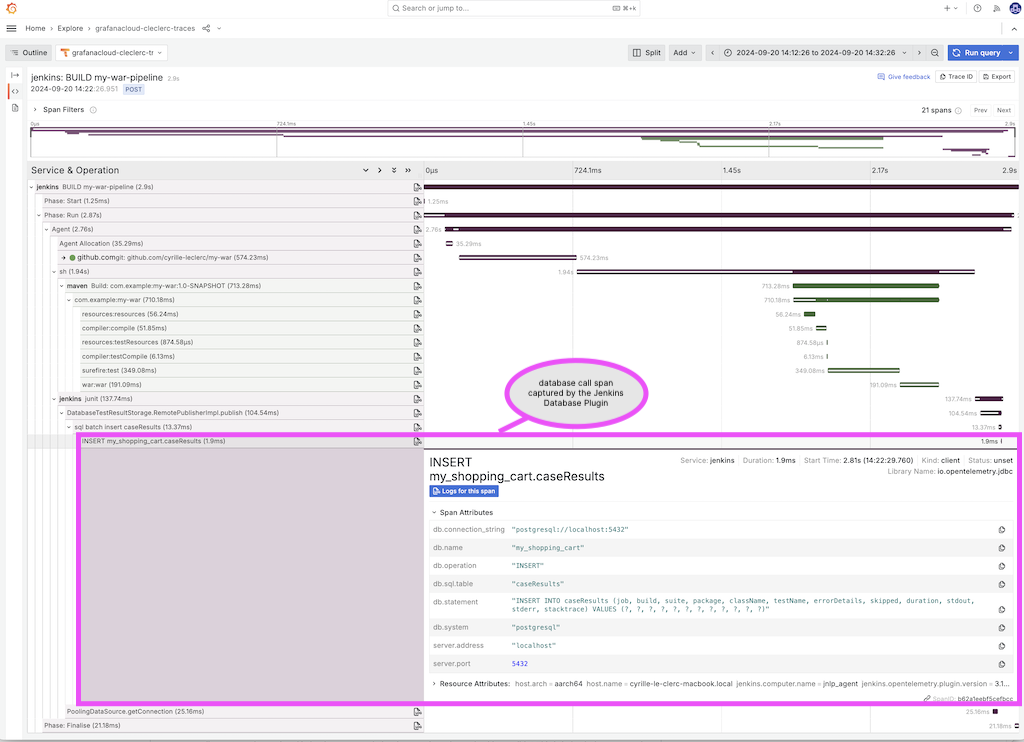This library plugin defines a common abstraction to connect to relational database. By doing so, it serves three purposes:
- It allows database driver plugins (such as H2 Database Plugin) to be developed, improving the user experience for administrators.
- It simplifies other plugins that use RDBMS by eliminating the need to code up a configuration UI to let administrators select database.
This plugin is not meant to be used by end users by itself. It's supposed to be included through the dependencies of other plugins. If you are wondering how to store your job configuration etc. in a database, the answer is that you cannot.
The key class in this plugin is the Database class, which acts as a holder for JDBC DataSource instance. The Database class is an extension point to be implemented by database driver plugins.
The calling code can use this DataSource instance to obtain a connection to the database.
This plugin adds a system configuration entry to let the administrator configure the database used by Jenkins to store miscellaneous stuff. So the easiest way for plugins to start storing data to the database is to use this Database instance. This global database instance is kept in the GlobalDatabaseConfiguration class. You can inject this via @Inject, or you can call GlobalDatabaseConfiguration.get() to retrieve it, and then use the getDatabase() method to obtain the Database instance.
Because the database is shared by all the plugins, please use table names that include your plugin name as a prefix to avoid collisions.
In addition to the global database, this plugin also creates a database local to TopLevelItem. These databases are normally backed by embedded database that stores data under $JENKINS_HOME/jobs/NAME, and this simplifies the backup, copying, deletion of the data that's local to jobs (such as test reports, coverage data, and so on.)
This information is kept in the PerItemDatabase class, which you can obtain by PerItemDatabaseConfiguration.findOrNull().
Sometimes it makes sense to store data to an entirely different database. Users may already have a database with data in it, in which case he'd want to just connect to that.
A plugin that wants to do this should define a field whose type is Database (see example). In the config.{groovy,jelly}, use the f:dropdownDescriptorSelector tag to allow the user to select a database (see example).
This plugin exposes it through JPA 2.0 API (internally, it uses Hibernate but please do not rely on this fact if you can as it may change.) The entry point to the JPA support is the PersistenceService class, and this exposes methods for obtaining EntityManagerFactory for both the global database as well as arbitrary per-item database of your choice.
Because there are several different databases, involved, @Entity annotation alone is not sufficient. For persisted classes meant for the global database, please put @GlobalTable in addition to @Entity.
The following code shows how to use this to persiste a new row:
public class Push {
@Inject
PersistenceService ps;
public void go(int n) throws IOException, SQLException {
Jenkins.getInstance().getInjector().injectMembers(this);
EntityManager em = ps.getGlobalEntityManagerFactory().createEntityManager();
em.getTransaction().begin();
TestRow row = new TestRow();
row.buildNumber = n;
row.x = "foo";
em.persist(row);
em.getTransaction().commit();
em.close();
}
}
@GlobalTable
@Entity
public class TestRow {
@Id
@Column
public int buildNumber;
@Column
public String x;
}
The Jenkins Database plugin supports OpenTelemetry and tracing to help troubleshoot performance issues.
To enable tracing, you need to:
- Install the OpenTelemetry plugin and configure it
- Navigate to the "advanced" section of the Jenkins OpenTelemetry Plugin and set in the "Configuration properties" :
otel.instrumentation.jdbc.enabled=trueto enable tracing in the Datasource provided by the Jenkins Database Pluginotel.instrumentation.jenkins.agent.enabled=trueto activate tracing in the Jenkins build agents if database calls are executed from the build agents
Note that changes to the otel.instrumentation.jdbc.enabled require to restart the Jenkins Controller and build agents.
Example database call span produced by the Jenkins JUnit SQL Storage plugin:
MySQL Database plugin and PostgreSQL Database plugin are good examples of typical database driver plugins. For other "unusual" drivers that doesn't use the canonical host+database+username+password+properties combo, see H2 Database plugin source code as an example.
Refer to our contribution guidelines
Licensed under MIT, see LICENSE
